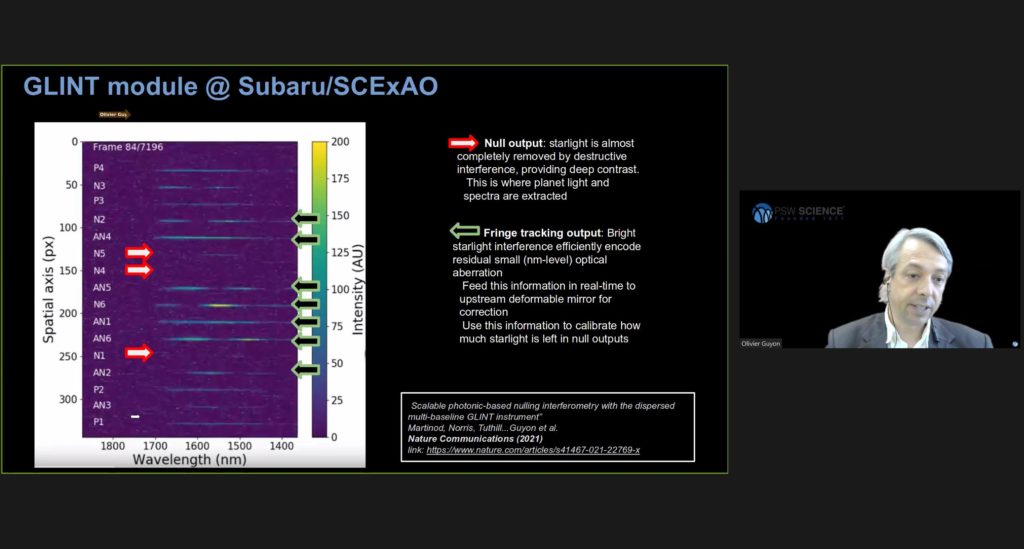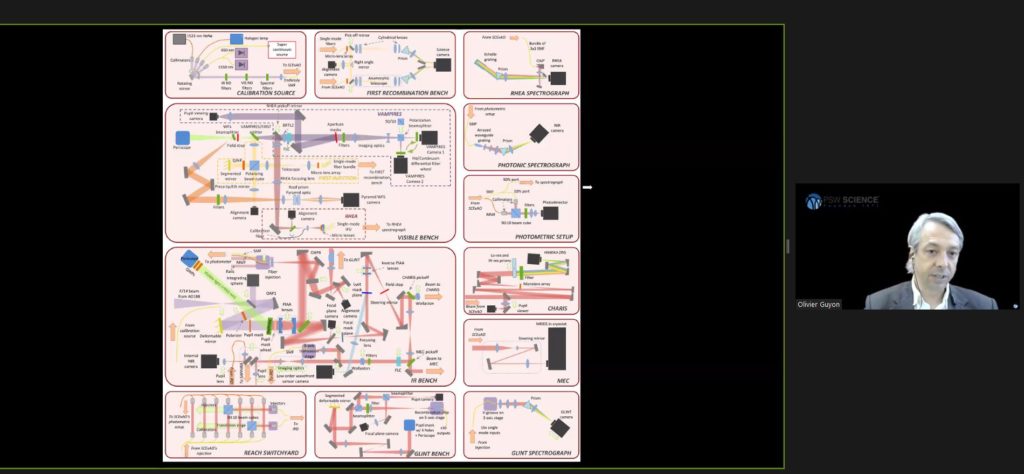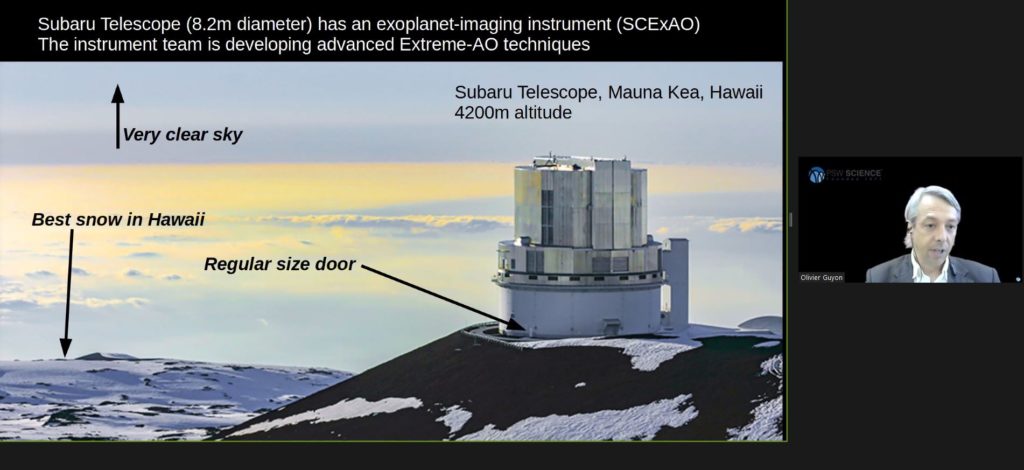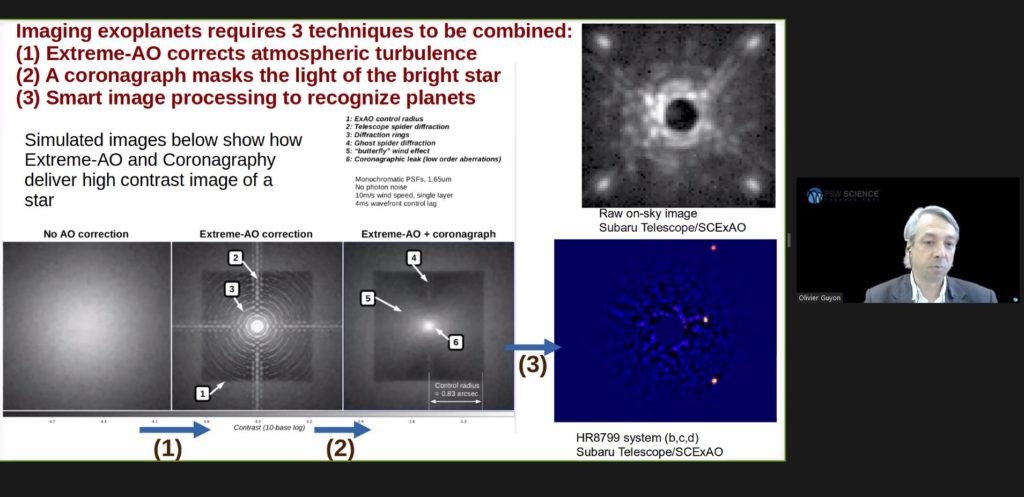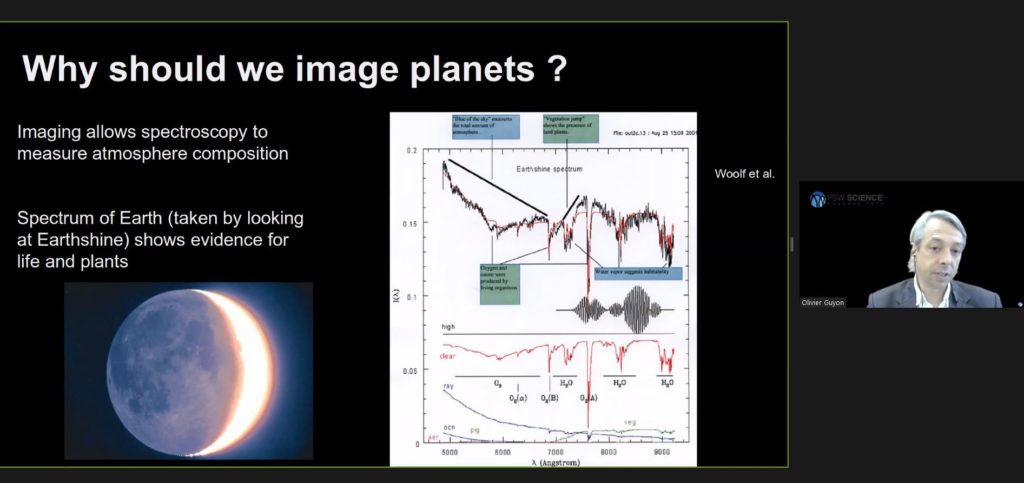The Presidents' Lecture
Extreme Adaptive Optics
The technology behind high contrast imaging of exoplanets
Olivier Guyon
Astronomer, Steward Observatory
Professor, University of Arizona
About the Lecture
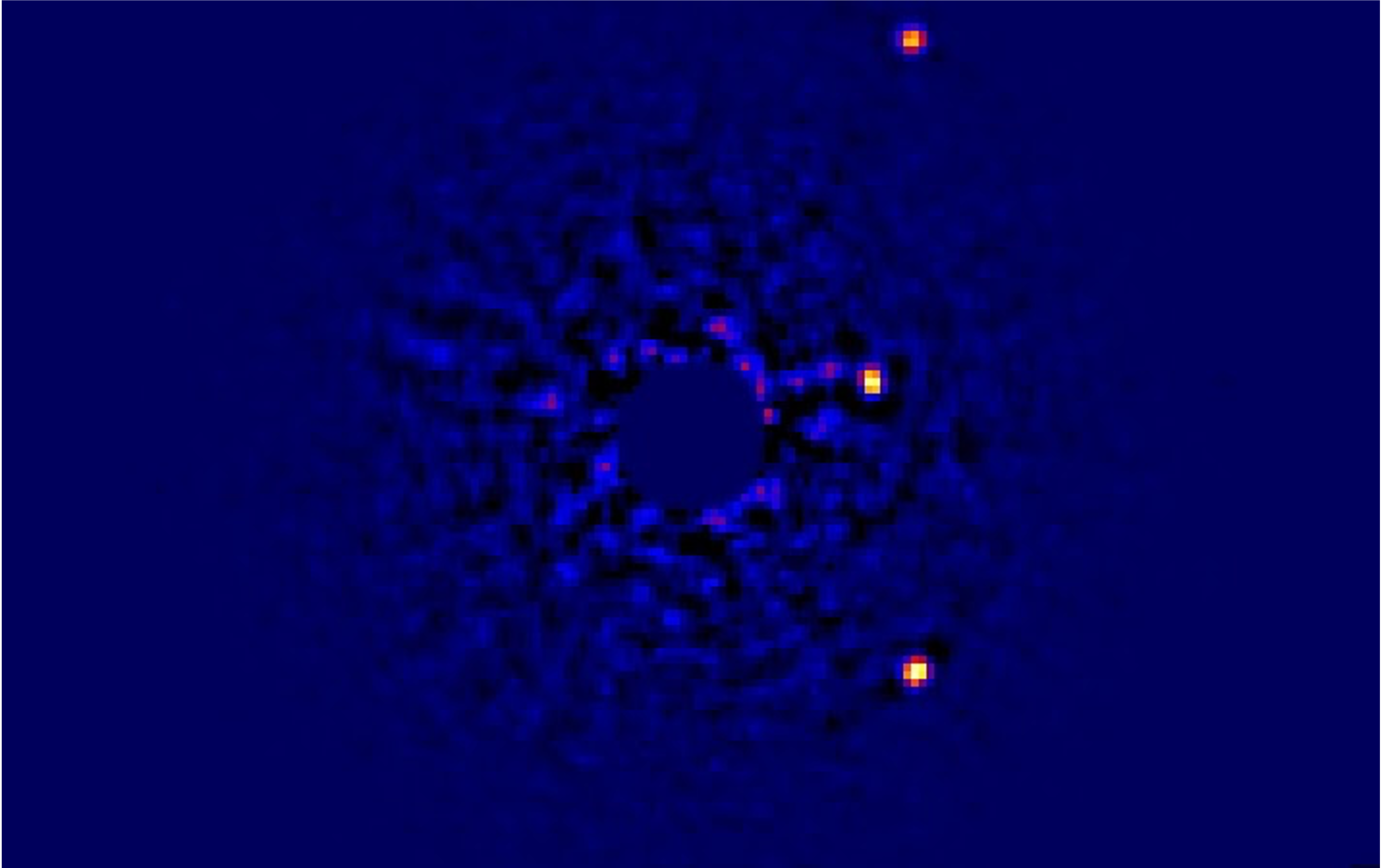
Adaptive optics (AO) systems are used in astronomical telescopes to reduce or eliminate the wavefront distortion that arises in light as it passes through the atmosphere. In advanced astronomical observatories AO systems work by measuring the wavefront distortions and introducing a complementary distortion into a deformable reflector in the optical path that cancels out the distortions.
Extreme AO systems that can provide super-resolved imaging for the very largest ground based telescopes are technically challenging to design and build. They involve complex sensors to determine the wavefront distortion, sensitive and fast actuators to shape the correcting surface, typically include lasers to produce a synthetic guide star of known properties in the upper atmosphere, and high speed computers to calculate actuator adjustments in real time, and electronic controls to effectuate the adjustments many times per second.
The most ambitious and demanding type of adaptive optics, referred to as Extreme Adaptive Optics (XAO), is designed to image exoplanets. XAO systems operate at high speed, well above 1 kHz, and employ deformable mirrors with many actuators, typically over 1,000. They rely on fast low-noise detector technologies to measure incoming optical aberrations with nanometer-level precision, and high-performance computing hardware to process incoming data in real-time. Thanks to recent advances in optics, detectors and computing, XAO systems are becoming highly integrated systems where multiple components actively participate in correcting atmospheric distortion and measuring, removing and calibrating unwanted stellar light. Advances in these systems now being developed will enable the extremely large telescopes now being planned and built to image habitable exoplanets.
This lecture will discuss the physics and engineering of XAO systems including the Subaru Extreme Adaptive Optics system that currently is prototyping such approaches.
Note: This lecture augments Olivier’s previous lecture on AO, given on October 8, 2021 at the Society’s 2,446th meeting. Minutes of that meeting and a video recording of the lecture are available on the PSW website at https://pswscience.org/meeting/2446/.
Reading on Topic
1, Olivier Guyon (2018): “Extreme Adaptive Optics”, Annual Review of Astronomy and Astrophysics, Vol. 56, pgs 315-355
https://doi.org/10.1146/annurev-astro-081817-052000
2. Stephan Hippler (2019): “Adaptive Optics for Extremely Large Telescopes”, Journal of Astronomical Instrumentation, Vol. 8, No 2: 1950001–322; arXiv:1808.02693. Bibcode:2019JAI…..850001H. doi:10.1142/S2251171719500016. S2CID 119505402.
3. Duffner et al. (2009): The Adaptive Optics Revolution: A History, University of New Mexico Press, ISBN 978-0-8263-4691-9.
4. Guyon et al. (2021): High contrast imaging at the photon noise limit with self-calibrating WFS/C systems, Proc SPIE, Volume 11823, id. 1182318 11 pp; DOI: 10.1117/12.2594885 ; https://arxiv.org/abs/2109.13958
5. Guyon et al. (2020): Adaptive optics real-time control with the compute and control for adaptive optics (Cacao) software framework, Proc SPIE 11448, Adaptive Optics Systems VII, 114482N; https://doi.org/10.1117/12.2562822P
6. The SEEDS High Contrast Imaging Survey of Exoplanets around Young Stellar Objects
arXiv.org > astro-ph > arXiv:1604.04697
7. “Optical tricks to image and study habitable exoplanets” SETI institute lecture 2013 – https://www.youtube.com/watch?v=Da2KLcbUIV8
8. “The search for other Earth-like planets” TED-Ed – https://www.youtube.com/watch?v=JTNY92xeFS0
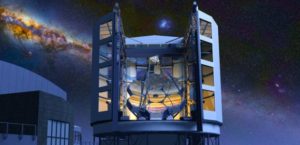
About the Speaker
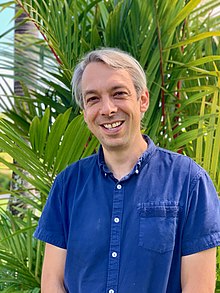
Olivier Guyon is Professor in the Department of Astronomy and Astronomer in the College of Optical Sciences and the Steward Observatory at the University of Arizona. He also is Affiliated Professor with the Astrobiology Center of the Japanese National Institutes of Natural Sciences and serves as Extreme Adaptive Optics Project Scientist for the Subaru Telescope of the National Astronomical Observatory of Japan. He is also a member of the Magellan extreme-AO development team.
Currently Olivier is developing high contrast imaging techniques for current and future ground and space-based telescopes, particularly innovative techniques for detecting and characterizing extrasolar planets. His research includes work on coronagraphy, wavefront sensing techniques for Adaptive Optics, and astrometry.
Olivier developed the Phase-Induced Amplitude Apodization (PIAA) Coronagraph, a highly efficient optical device to mask light from a star while preserving light from planets around it. And he is currently leading the Subaru Coronagraphic Extreme Adaptive Optics group at the Subaru Telescope to use these new techniques on the Subaru telescope for exoplanet detection and characterization.
Oliver is an author on over 169 refereed publications and more than 486 non-refereed publications. Among other honors and awards he is a MacArthur fellowship, a recipient of a Presidential Early Career Award for Scientists and Engineers, and of the Guinier Young Researcher Award of the French Society of Physics
Olivier earned his undergraduate degree at the École Normale Supérieure of Paris and his PhD in Astronomy at the University Paris.
Minutes
On January 14, 2022, by Zoom webinar broadcast on the PSW Science YouTube channel, President Larry Millstein called the 2,452nd meeting of the Society to order at 8:02 p.m. EST. He welcomed new members, and the Recording Secretary read the minutes of the previous meeting.
President Millstein then introduced the speaker for the evening, Oliver Guyon, Professor of Astronomy and Astronomer at the Steward Observatory at the University of Arizona. His lecture was titled, “Extreme Adaptive Optics: The technology behind high contrast imaging of exoplanets.”
Guyon began by summarizing his October 8, 2021 presentation to the Society. In that first lecture, Guyon introduced the concept of adaptive optics, which minimize atmospheric blur from ground-based telescopes. The technique requires three main components: shape-changing mirrors, one or more waveform sensors, and a computer control system that processes the sensor data in real time to compute the necessary corrective mirror movements.
While there are many types of adaptive optics systems, they can be generally defined by two values: “field of view” and “wavefront error.” Extreme adaptive optic (Extreme-AO) systems are optimized to deliver the best performance over a small field of view to image faint exoplanets orbiting close to other stars. The higher quality image of an exoplanet, the better able scientists are to study their spectrum for signs of habitable environments.
Imaging exoplanets requires three techniques to be combined: Extreme-AO to correct atmospheric turbulence, a coronagraph to mask the light of bright stars, and smart image processing to recognize planets.
The instrument Guyon uses for his research is the Subaru Telescope in Hawai’i, for which the instrument team is developing Extreme-AO techniques. He showed many images of the telescope and gave viewers a tour of its Extreme-AO instruments.
The Subaru Coronagraphic Extreme Adaptive Optics (SCExAO) looks like a large black box. Inside are a complicated array comprising two layers of adaptive optics, including the multitude of cameras and optical sensors required to obtain the data necessary to compute quality mirror corrections to remove atmospheric blur.
Guyon showed detailed diagrams and explained the instrument’s internal functions performed by the visible bench and the infrared bench. The telescope compresses its 8 m beam into approximately 1 cm and feeds it to equipment including 11 total wavefront sensors and a deformable mirror 20 mm in diameter, with 2000 independent actuators operating at approximately 10 kHz speed.
The speaker then discussed in detail the telescope’s software and the algorithms that power its adaptive optics control. In summary, the input comes from the waveform sensors, which tell the software what atmospheric optical aberrations have been imprinted on the optical beam. This data is collected from cameras taking images between 2000 and 4000 times per second. The software feeds that data into a control matrix to derive a control signal output which is then sent to the deformable mirror.
Extreme-AO are unique because they require very high speed processing, a large number of control modes, and high accuracy and precision to exquisitely correct constantly changing distortions. To obtain those measurements, Extreme-AO optimizes the wavelengths it measures to the stars being observed, and uses a pyramid waveform sensor to aim the telescope.
Guyon then discussed advanced control techniques for Extreme-AO. Conventional AO takes the last measurement of a waveform sensor and multiplies it by a matrix, and sends an output to the deformable mirror. Advanced AO control will use multiple past measurements from multiple sensors for predictive control. This advanced technique is so complex that machine learning will be required for the technique to become practical. Guyon then showed examples of how Advanced AO control can learn and improve image resolution.
Advanced AO control may also use the focal plane image as a source of information to improve waveform measurement. Guyon’s team is developing a technique to look at an image of an obstructed star, to control for the speckles of light created by the obstruction.
The speaker’s final slides presented the Suburu GLINT module, which uses interferometric waveform sensors to measure starlight.
Guyon then concluded and answered questions from the online viewing audience. After the question and answer period, President Millstein thanked the speaker, made the usual housekeeping announcements, and invited guests to join the Society. President Millstein adjourned the meeting at 9:31 p.m.
Temperature in Washington, D.C.: 8° C
Weather: Partly Cloudy
Concurrent Viewers of the Zoom and YouTube live stream, 63 and views on the PSW Science YouTube and Vimeo channels in the first two weeks of the lecture: 291.
Respectfully submitted,
James Heelan, Recording Secretary
Highlights
